Many arcade manufacturers found that they could get into the console publishing business by adapting existing games. There was little change for many of the titles, in fact some of the teams learned simply to switch the code to allow for unlimited free play / continues on otherwise straight ports. The newly formed Ridge Racer Team at Namco decided that the best game they could debut would be a title that incorporated all of the elements of Ridge Racer 1 and 2 for the Playstation. The 1996 debut of Ridge Racer Revolution was similar to the arcade version in many instances. It featured the music from the games, the same track layouts, car selection and even identical map, gauge and position icons. It even saved fastest times per track and allowed players to enter their initials at the Game Over screen in true arcade fashion. At first it seemed like another direct arcade port. It was the layers of nuance that Namco added to distinguish it from every other Playstation release.
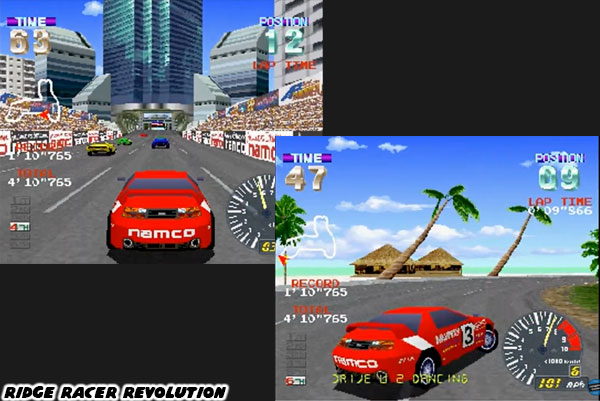
Ridge Racer Revolution featured all sorts of modes for players to unlock. Each of the modes made the game visually different and some more difficult. Players could play through the game with the familiar daytime lighting. Or they could try and race the courses in noon, evening and night modes. Each mode made less of the track visible and thus more difficult to navigate. The different daytime settings also came with changes in the music. The game caused the biggest stir with long-time arcade fans when Namco included a mini-game to make the loading times bearable.
Namco had filed a patent on mini games during game loading screens that year which meant that the feature would most likely never show up again on any other console unless Namco was publishing it. The mini game was a stage from Galaga '88 featuring the classic arcade graphics and sounds. Normally there were four cars for players to choose from but it they managed to
knock down all of the alien ships then an even dozen cars (these were the opponent cars) would become playable as well.
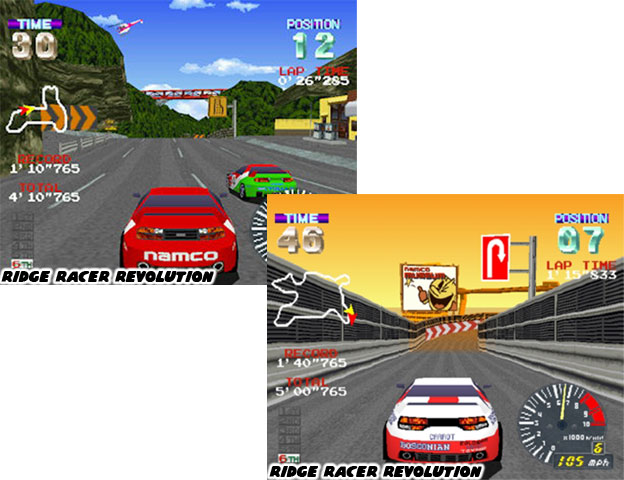
The Galaga series was iconic. It was one of the first space shooters that did well on both sides of the Pacific and a breakout hit for Namco. It was so well regarded in arcade circles that to this day some people argue that
Galaga '88 was the finest shooter ever made. I wouldn't go so far as to say that but it was a fantastic surprise for racing fans to discover. That was not the only surprise waiting for audiences. If players managed to defeat all of the alien ships during the loading screen in exactly 44 shots then the Buggy Mode would be unlocked. The Buggy Mode made all of the cars short and stubby, basically it was a port of the Pocket Racers arcade game that I had mentioned previously on this blog.
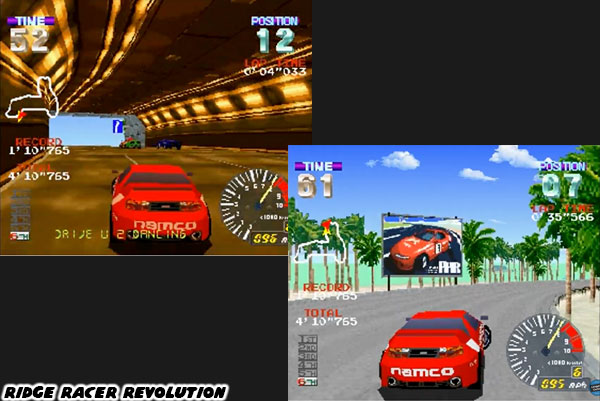
The game also featured a "boss battle" of sorts. It was one of the first racing titles to do that. In the arcade there was one car that could outperform every other class. The mysterious 13th Racing car, sometimes referred to as Devil 13, would wait for opponents on a dark track. It was actually a rare surprise for those players that managed to see it on the course. Like an urban legend a player would drive past a black race car parked on the side of the road. It had red wheels and a yellow devil logo on the hood. No sooner did a player pass it than they would see it appear in the rear view mirror, meaning that it could accelerate impossibly fast. Before the player knew it this car would fly past them. If it got far enough it would simply stop and wait at the side of the road where the player saw it the first time. It was a lopsided game of cat and mouse. No matter how well a player drove they could never escape the shadow of the Devil. The only way to beat the car was to use the rear view mirror and try to block it before it could pass. If the player stayed ahead before the finish line then they would unlock the car.

The reaction was very strong to the obscenely powerful race car. The Devil 13 would be revisited time and time again through the series, each time the car would be changed to make it more unique and aggressive. The Devil 13 was not the final surprise that Namco had in store for gamers. Just as they had mastered every course on the game and thought that they had unlocked every secret there would be something else that popped up to challenge them. Ridge Racer Revolution was the debut of the White Angel or the Angel 0 car as well. This car perfectly complimented the Devil 13 in almost every category. Players could challenge it by meeting the right criteria on the Intermediate Track but found that beating it was extremely difficult as well. Some players swore that the only way to beat the Angel was by using the Devil. Like the Devil 13 this car would get redesigned in future versions of the game as well. Both cars became symbolic as the most powerful racers in the game.
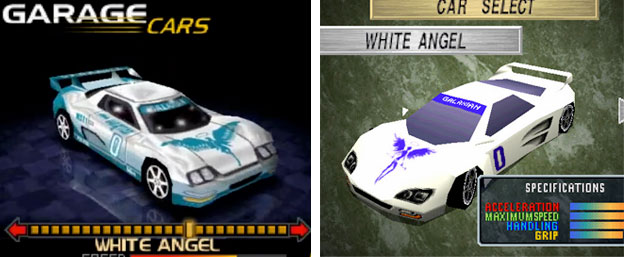
Die-hard car fans fell in love with these fictional vehicles. There was only one thing however that kept me from jumping on the bandwagon.When I saw the first Ridge Racer Revolution ad I was angry. The logo on the hood of the car was clearly mirrored from the character Seska as featured in the Orion manga. I grew up on the stories of Masamune Shirow and held him in very high regards. I spotted the misuse of his work right away. The thought that somebody would so blatantly steal one of his illustrations and try to get away with it upset me. Namco realized the error of their ways and redesigned the Angel logo for the next iteration of the game.
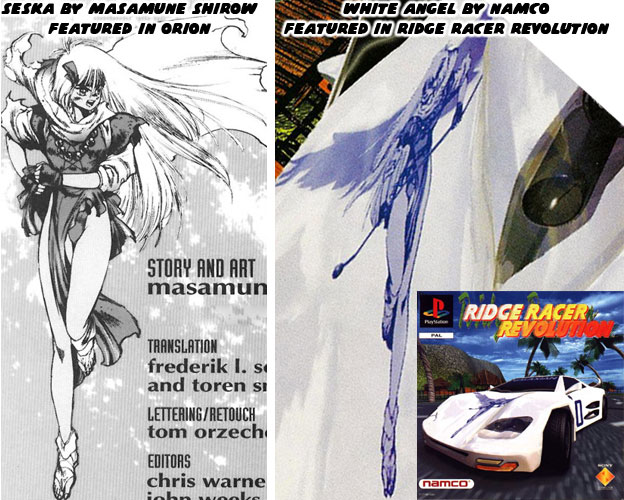
Despite my grievances I could be one of the millions of fans that could attest that the studio had given audiences far more than they expected, especially for an arcade port. Sega was doing amazingly well in the arcade but they would begin losing ground as the decade progressed. Despite the major difference in graphics between consoles and the arcade Namco was giving audiences a reason to stay home. It seemed lucky that the new Ridge Racer Team turned out to be more influential than the original. This was due to many factors, not the least of which were the car fans that still remained at the company. The full scope on why Ridge Racer would become an iconic series would not be understood for many years. The devil as the saying goes was in the details. Once players began to connect the dots they saw there was a divine hand at play as well. The next blog will look at the importance of finding Heaven and Hell in the Namco universe.
As always if you would like to sponsor me
please visit my Patreon page and consider donating each month, even as little as $1 would help make better blogs and even podcasts!












Reading this blog I was thinking the Devil / Angel was a nod to Tekken with devil Kazuya and the Angel counterpart, anyway onto the next blog.
ReplyDelete...such a shame on ripping off Shirows not that SEGA is innocent either having used Ferrari's without a license for years (a decade or 2?)
ReplyDelete